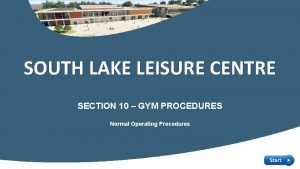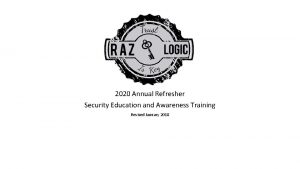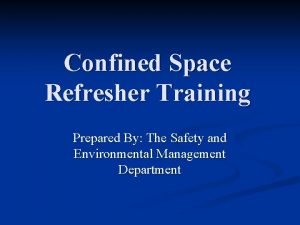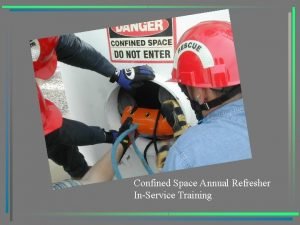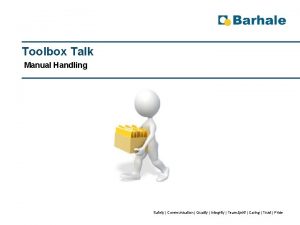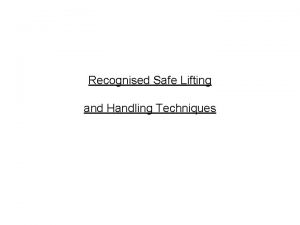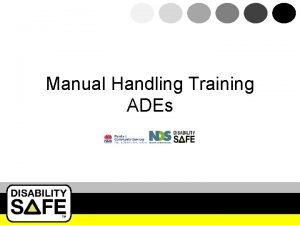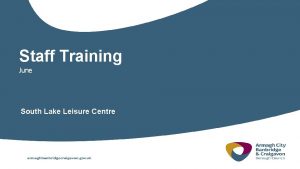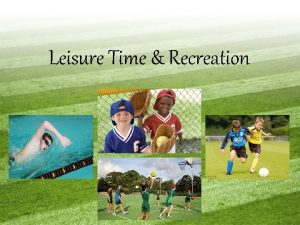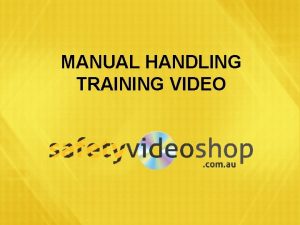SOUTH LAKE LEISURE CENTRE MANUAL HANDLING REFRESHER TRAINING
![SOUTH LAKE LEISURE CENTRE MANUAL HANDLING [ REFRESHER TRAINING ] SOUTH LAKE LEISURE CENTRE MANUAL HANDLING [ REFRESHER TRAINING ]](https://slidetodoc.com/presentation_image_h/e90d42cc8f85625c537852bed857e08c/image-1.jpg)


















![Click here to start ASSESSMENT MANUAL HANDLING [ REFRESHER TRAINING ] Click here to start ASSESSMENT MANUAL HANDLING [ REFRESHER TRAINING ]](https://slidetodoc.com/presentation_image_h/e90d42cc8f85625c537852bed857e08c/image-20.jpg)
- Slides: 20
![SOUTH LAKE LEISURE CENTRE MANUAL HANDLING REFRESHER TRAINING SOUTH LAKE LEISURE CENTRE MANUAL HANDLING [ REFRESHER TRAINING ]](https://slidetodoc.com/presentation_image_h/e90d42cc8f85625c537852bed857e08c/image-1.jpg)
SOUTH LAKE LEISURE CENTRE MANUAL HANDLING [ REFRESHER TRAINING ]

INTRODUCTION § The incorrect moving of loads manually is one of the most common causes of injury at work § 469, 000 Workers suffering from work-related MSD (new or long-standing) § 156, 000 new MSD cases in 2017/2018 § There is no truly ‘safe’ weight limit for manual handling operations. Always try to find alternatives ways of moving loads e. g. trolley

What is Manual Handling: Any transporting or supporting of a load by hand or bodily force…. q Lifting q Lowering q Pushing q Pulling q Carrying

Operation Regulations: Employers must… § Avoid the need for manual handling where possible § Assess the risk of injury § Reduce the risk as far as is practicable

Operation Regulations: Employees must… § Follow safe systems of work § Use any equipment provided § Co-operate with employer on H&S matters § Notify of any hazards § Ensure activities don’t put others at risk

General Handling: Three components. . Planning- the lift Lifting technique Moving the load

Planning the Lift: q Stop and think - Plan the lift q Does it need to be carried? q Where is it going? q Is the route clear of hazards? q Consider the weight, is it heavy or light? q Does it need more than one person? q Are you dressed for the job?

Lifting Technique: q Place feet apart q Placing one leg forward will improve balance and control q Try sliding the load towards you first if you have to stretch

Lifting Technique: q Bend your knees NOT your back q Keep shoulders level and in line with your hips q Avoid jerking movements q Lift head then your back q Grip with your palms q Keep arms close to your body

Moving the Load: q Keep the load close to the body q Keep the heaviest side nearest your body q When pulling or pushing use your body weight to move the load q Avoid twisting your body when turning

Key Task Areas: General- Handling Carrying Chairs & Tables Setting Up/Take Down of Equipment Rescue Board- Recovery of unconscious casualty

General Handling: Use aids such as sack trucks or trolleys were possible

Chairs and Tables: Limit the number carried and if available use a trolley

Equipment Set Up/Take Down: If an object seems to heavy or awkward, get help with it Always complete the set up/take down early in advance if possible so time is not a factor

Rescue Board Recovery: A casualty should be removed from the water in a horizontal position The team must work together under the direction of the team leader

Recovery of an Unconscious Casualty: The technique used to lift a casualty from the water requires at least two lifeguards If a third lifeguard is available, the rescuing lifeguard should remain in the water and can assist by supporting and lifting the casualty's hips

Contributory Adverse Factors: • “quickly get the job done” attitude • Poor posture • Fatigue • Environment not considered

RISK ASSESSMENT PROCESS When you have to manually handle loads consider… Task - how often, how much Individual capability, male or twisting or bending is needed? female, old or young, experienced or inexperienced? Load - how heavy? Good grip? Environment – route, hot, Bulky? Heavier at one end? cold, uneven floor, windy, stairs?

SECTION COMPLETED You have now completed Manual Handling Refresher Training and are ready to take theory assessment. The practical assessment will be completed on-site. Click on the forward arrow link to move forward to the assessment page or if you feel you need review any of the information again please click on the back-arrow link.
![Click here to start ASSESSMENT MANUAL HANDLING REFRESHER TRAINING Click here to start ASSESSMENT MANUAL HANDLING [ REFRESHER TRAINING ]](https://slidetodoc.com/presentation_image_h/e90d42cc8f85625c537852bed857e08c/image-20.jpg)
Click here to start ASSESSMENT MANUAL HANDLING [ REFRESHER TRAINING ]
 South lake leisure centre
South lake leisure centre South lake leisure
South lake leisure South lake leisure centre
South lake leisure centre South lake leisure centre jobs
South lake leisure centre jobs South lakes leisure centre directions
South lakes leisure centre directions Gdpr refresher training
Gdpr refresher training Annual security refresher training
Annual security refresher training Confined space refresher training
Confined space refresher training Confined space refresher training
Confined space refresher training Radioactive refresher cocktail
Radioactive refresher cocktail Refresher training example
Refresher training example Weldlec ltd
Weldlec ltd Greenford swimming pool
Greenford swimming pool Waterside farm leisure centre
Waterside farm leisure centre Oligotrophic lake vs eutrophic lake
Oligotrophic lake vs eutrophic lake Lake powell and lake mead
Lake powell and lake mead Lake powell and lake mead
Lake powell and lake mead Tileo manual handling
Tileo manual handling Client handling task
Client handling task Kinetic method of lifting
Kinetic method of lifting 5 key principles of manual handling
5 key principles of manual handling
